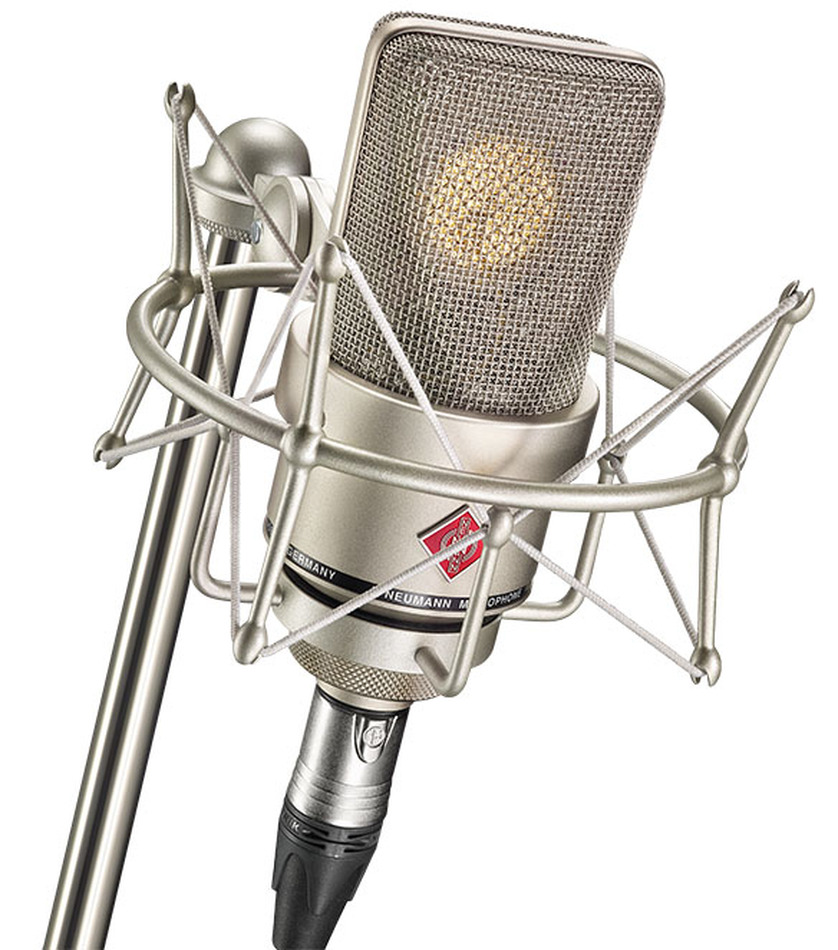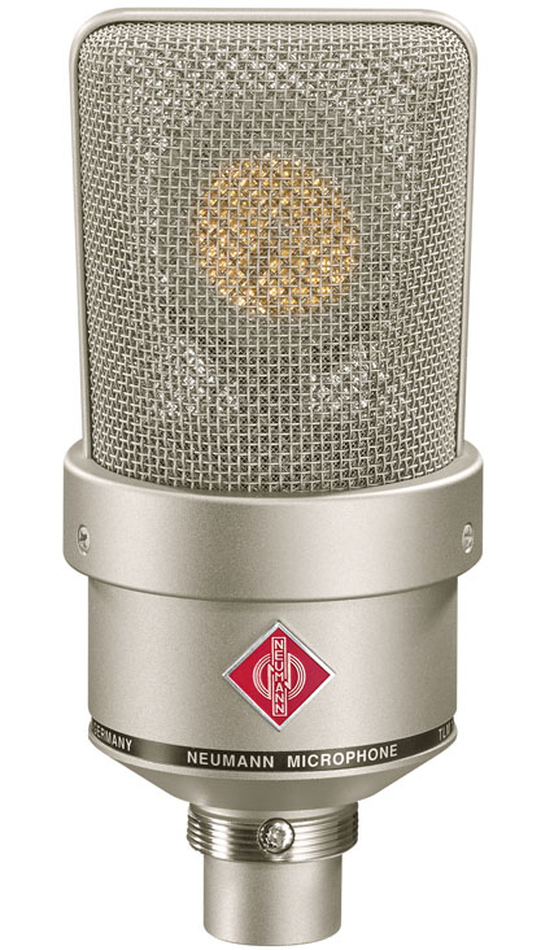
Review by George Shilling
Georg Neumann started making microphones in 1928. His first microphone, the CMV3 condenser was way better in sound quality and noise performance than the recording formats of the time. Neumann are a specialist company, microphones being their only products, apart from a foray into disc-cutting equipment. These days, any top-league studio will invariably have at least a handful of Neumann condenser mics. There are very few musician-led albums released in the last 30 years that haven't involved a Neumann mic in their making. The most common and popular Neumann mic is the U87 which has been made since 1967, and which is based on the older (valve) U67 which is no longer available. Both are still in frequent use. Many recording engineers instinctively reach for an '87 when recording drums, guitars, vocals, wind or string instruments. Unfortunately for home recordists prices of Neumanns are almost always out of price-range. Until now.
The TLM103 is a large-diaphragm capacitor microphone. The signal is generated by the variations in capacitance between two polarized plates set next to each other. A power supply must be applied to make the thing work, so you will need a microphone input that is able to supply "phantom power" at 48 volts. This voltage goes through the existing balanced cabling which also carries the signal. The K103 mic capsule introduced here is similar to the K87 used in the legendary U67 valve mic and the popular U87 workhorse. However, one reason for the comparatively low price of the TLM103 is that it is a fixed-pattern mic which requires only a one-sided capsule. The pricey U87Ai (to give the current model its full title) is switchable between cardiod, figure-of-eight and omnidirectional, and also features a low frequency roll-off switch and -10dB pad. However, the TLM103 has no switches whatsoever. The cardioid characteristics of this baby mean that it mainly picks up sound from the front, rejecting sound from the rear. This, luckily, is what recording engineers want, at least 8 times out of 10.
In the professional recording world, when using soundproofed acoustically reverberant rooms it can occasionally be more desirable to use an omnidirectional mic pattern to achieve a more natural recorded sound, but if you record in the same room as that noisy PC or multitrack with its whirring fans, then it makes sense to use a cardioid mic angled away from these extraneous sources. You might think that creating a one-pattern microphone is purely an economy measure. However, there are performance benefits, such as lower self-noise. Microphones, like any audio gear, generate their own background hiss. This was generally not noticeable in the past when they were always much quieter than analogue tape and mixing consoles. Now, with the advances of digital technology it has become a factor. Here, I am happy to report that the TLM103 exhibits the least self-noise of any microphone on the market. Yes, that includes its big brother U87, and any other mic you care to mention. This makes it the ideal partner for any recording setup. Whatsmore, it has a huge 138dB dynamic range. Perfect for recording jet aircraft, and (more importantly) the loudest drummers and singers. As there is no attenuation switch it is worth checking that your mic inputs can handle the loudest signals the mic receives.
Overview

The mic comes in a handsome wooden box made from (ecologically sound) pine, which really adds to the aura of quality. Inside its carefully crafted foam lining rests the 'satin nickel' finished mic, and a mic clip. I should point out that it is also available in 'matte black', but knowing how drab a black U87 looks, I'm sure most will opt for the magical misty silver finish. The mic feels quite heavy, due mainly to the thick metal ring which retains the mesh covering the capsule. This mesh is identical in dimensions to that found on the U87, although the body is much shorter.
The TLM in the name stands for Transformerless Microphone. Conventional capacitor microphones have a transformer in the output path to extract the phantom power, but now this can be done more cheaply and efficiently with electronic circuitry. A transformerless circuit is smaller than a transformer which means a smaller body. Take it apart with three screws and you find a horizontally mounted circuit board with the tiniest components. These are surface-mounted, which is obviously another cost-saving area, at no detriment to the user. The circular board is held in with a rubberized ring, and the capsule sprouts out from the middle of it, via another piece of rubber. Another reason for the reduced size compared to the U87 is that the original models included provision for an internal battery as an alternative to phantom power. These days phantom power is very much a standard, found even on the cheapest of mixers, so no battery space is needed. In rare situations where no phantom is available, Neumann make a unit that will externally convert 9 volt battery power into a suitable 48 volt supply.
When taking the mic apart and putting it back together you certainly appreciate the precision engineering involved in the manufacture of an instrument such as this. You really can feel the quality, as the windshield fits with micron-precision into the barrel. At the base is mounted a Swiss-made XLR connector with what look like gold-plated pins, and around this is a screw thread for fitting the supplied mounting clip. Unfortunately this is a rather shoddy plastic affair. The screw ring is clipped into the main part and scrapes rather unpleasantly when rotated. Furthermore, it is all too easy to cross-thread when attaching the mic, and this could easily result in breakage if you are less than careful. A mic such as this deserves a proper metal clip, and I do not understand why Neumann save a few deutschmarks here, when every other detail is so impeccable. The alternative for the user is the optional EA103 elastic suspension mount, which while expensive at £127 is an especially worthwhile accessory with this mic, due to its extended bass frequency response. This is another benefit of the transformerless design. Despite the rubberized components, this mic is sensitive to local vibrations. Watch out particularly for toe-tapping acoustic guitarists or dancing singers, whose every floorboard-vibrating move will be faithfully picked up and translated into unwanted subsonic signal.
Some mics incorporate a low frequency rolloff switch, but there is none on this mic. However, an elastic suspension mount will minimize these problems, so budget for one of these if possible.
I compared the TLM103 directly with a U87 on acoustic guitar and found it slightly brighter and less boxy sounding. Both mics exhibit a broad high-frequency lift around 5kHz, but the TLM more so than the U87. In another situation I compared an AKG C414EB which is a notoriously hard and bright sounding mic: the TLM was reassuringly not as piercing as this. It did not have all the beautiful warm glow of the valve U67, but then one would expect to pay many times the price of the '103 for one of these superb vintage mics. The sound was unsurprisingly very similar to another Neumann transformerless mic the TLM170. One characteristic of the '103 is that the pickup-pattern becomes narrower as frequency rises. This means that if you want the full brightness achievable you must point the mic in exactly the right direction. You can also make use of this feature by angling the mic slightly away from a source that is too bright. There is also a pronounced proximity effect whereby as a source such as a vocalist gets very close there is an increase in low and low-mid frequencies, resulting in a very closed-in, warm, boomy sound. If you don't like this, you can of course move the mic back a bit.
Conclusion
The TLM103 is a fabulous microphone with a huge range of potential uses. I can imagine broadcasters using it for voice-overs, film sound recordists using it for effects recording (with such low self-noise), and professional recording engineers using it for vocals and just about any instrument you can imagine. Singers who have worked in professional studios will instantly feel at home in front of a Neumann badge. This really is a Rolls-Royce for the price of a Volkswagen. It may not have all the gadgets, but just feel the power of the engine!
Reproduced with kind permission from www.georgeshilling.com. Copyright ©

